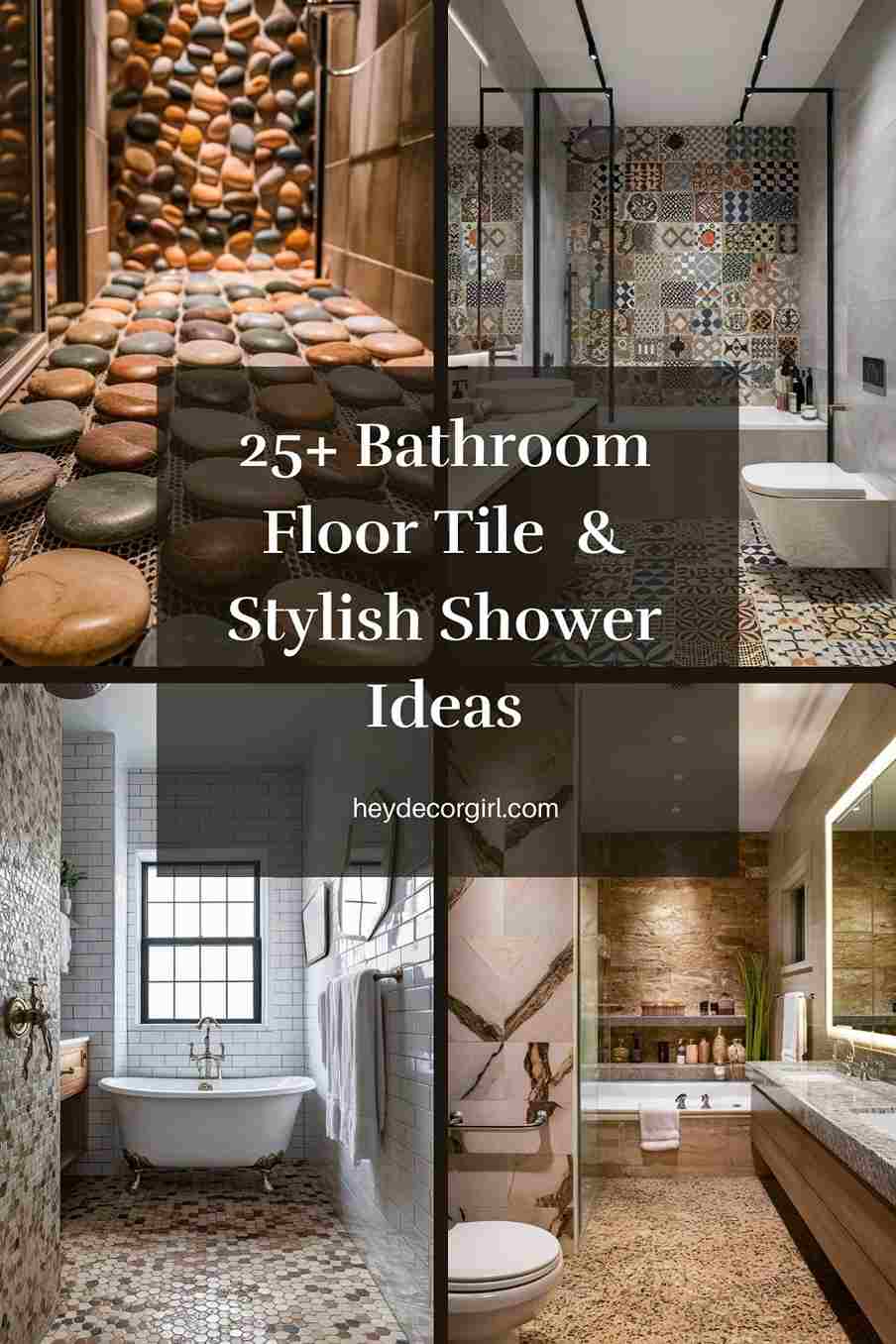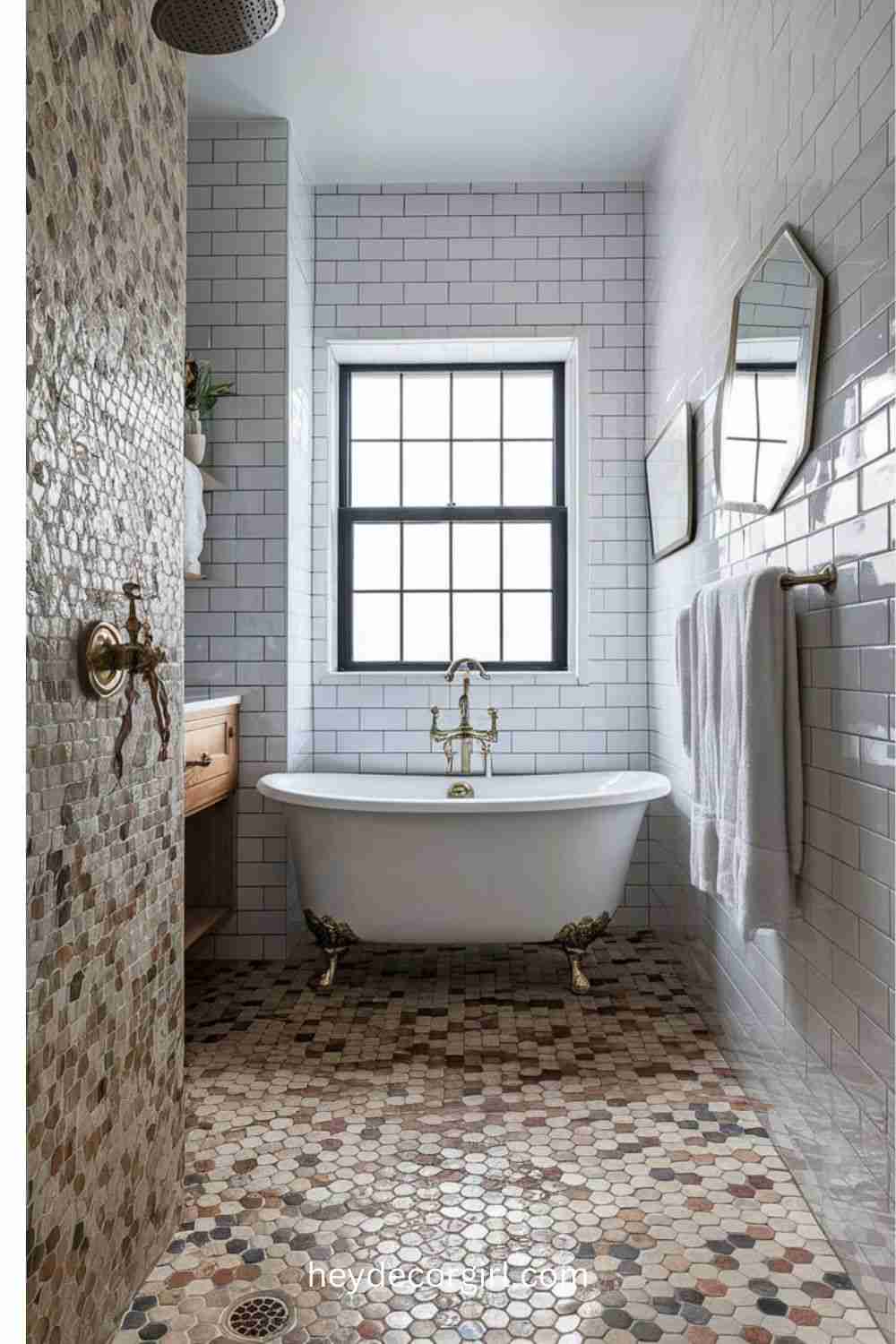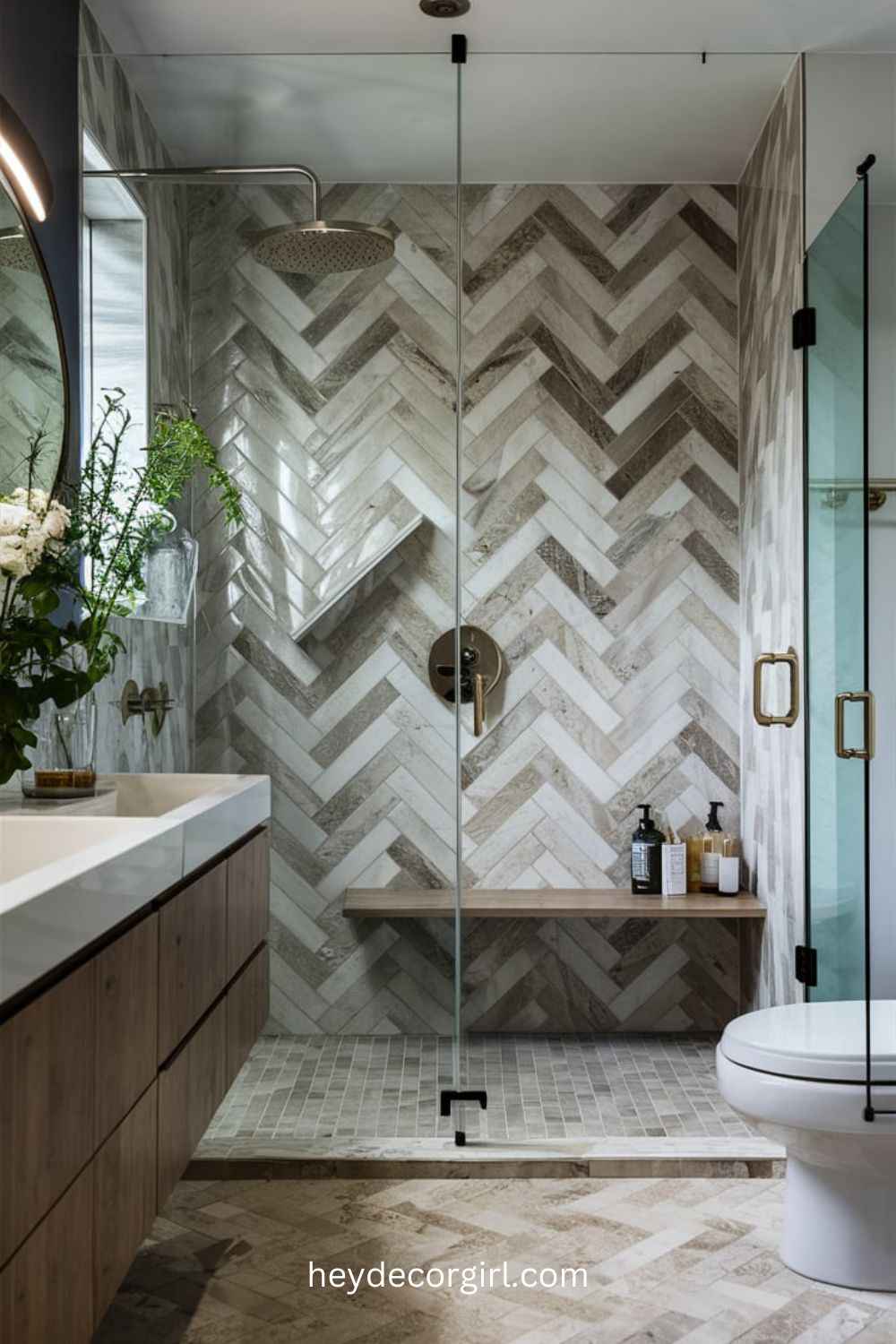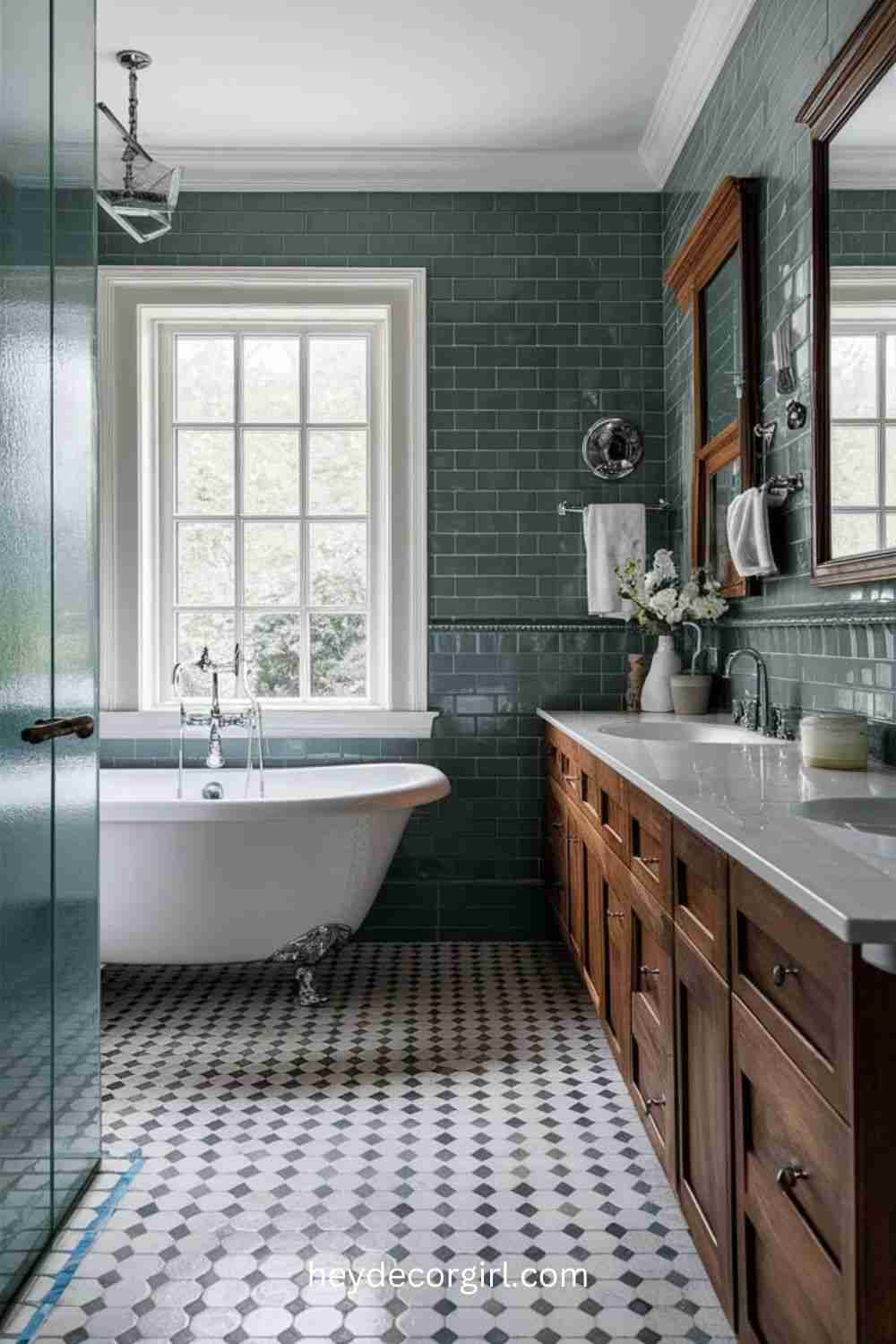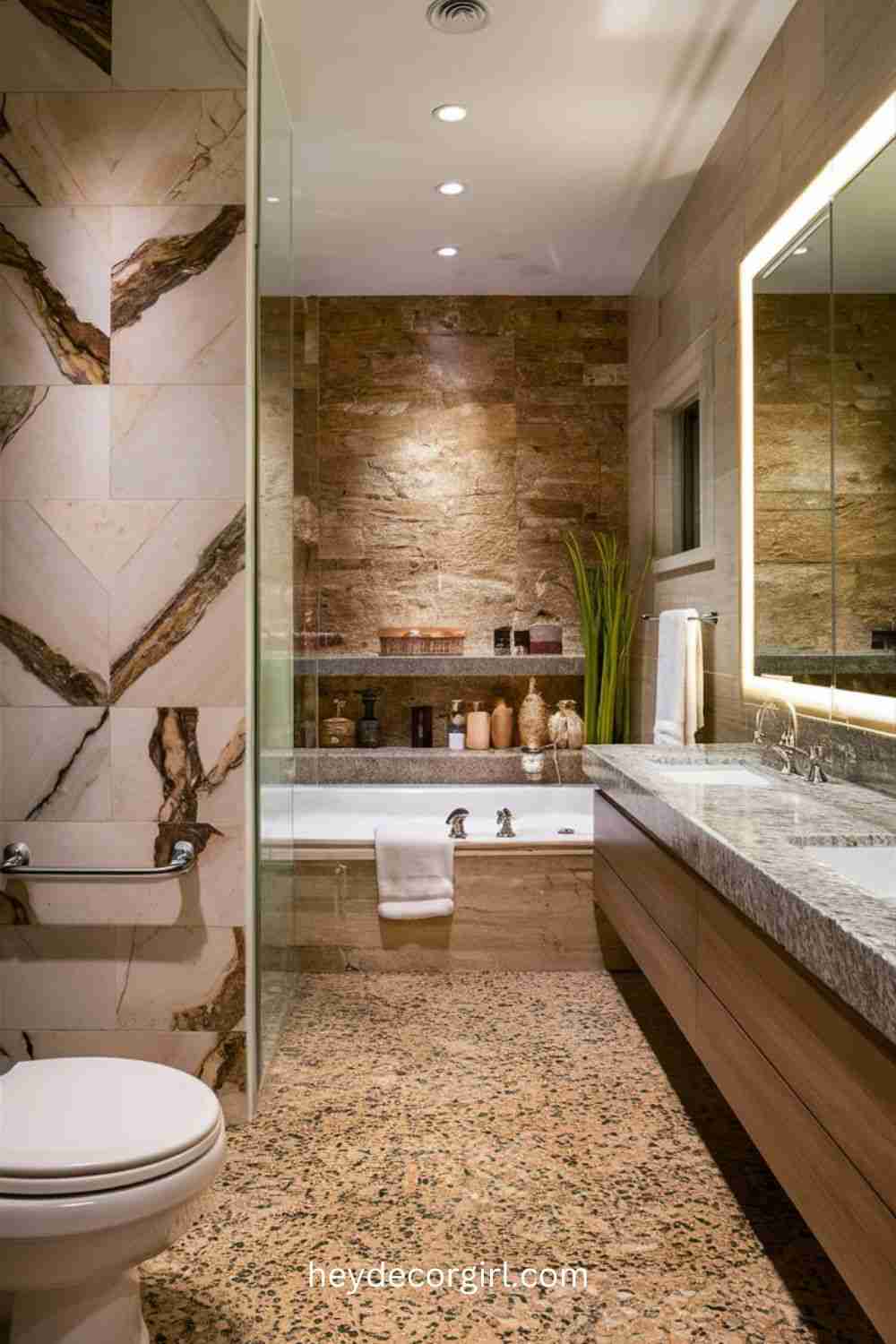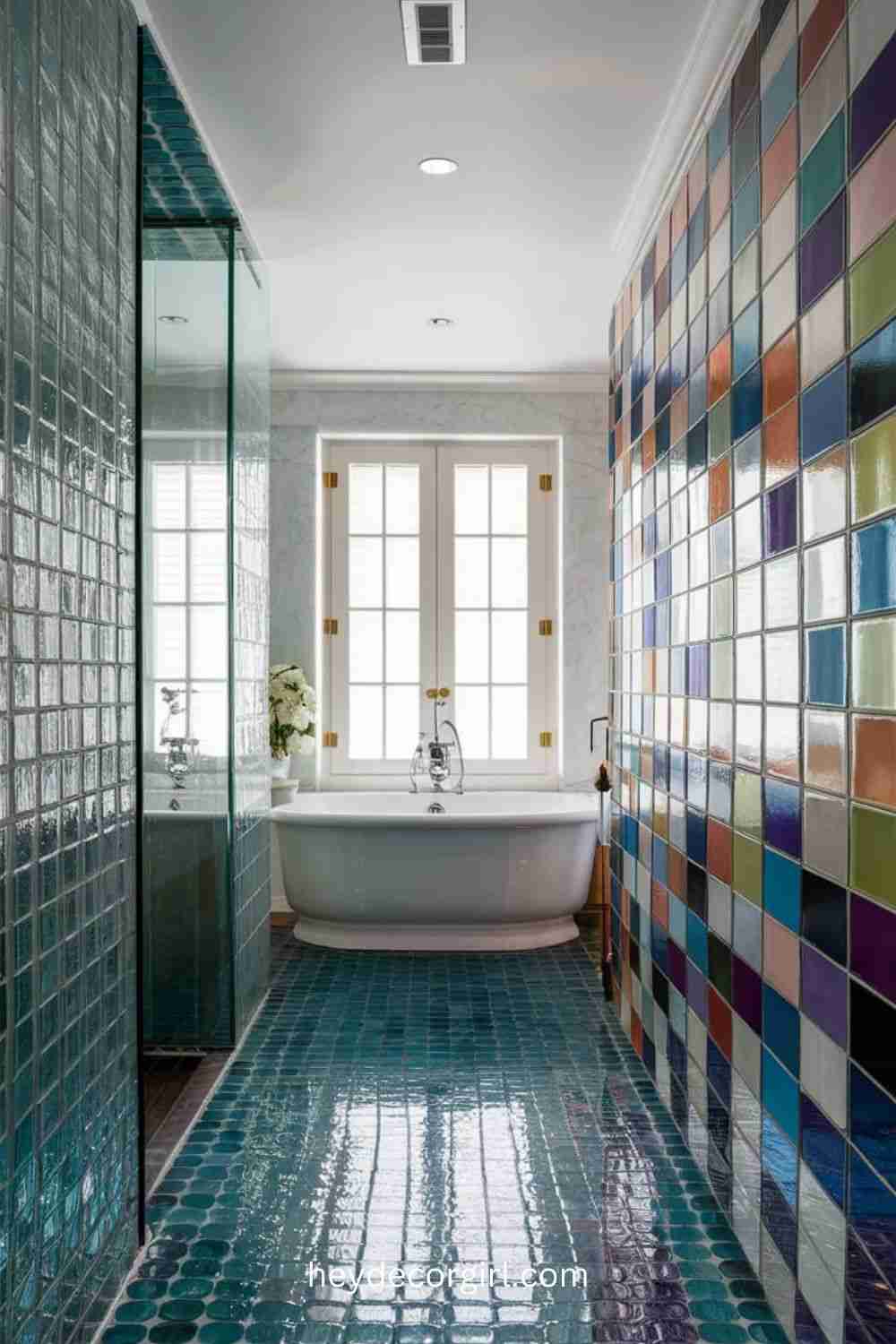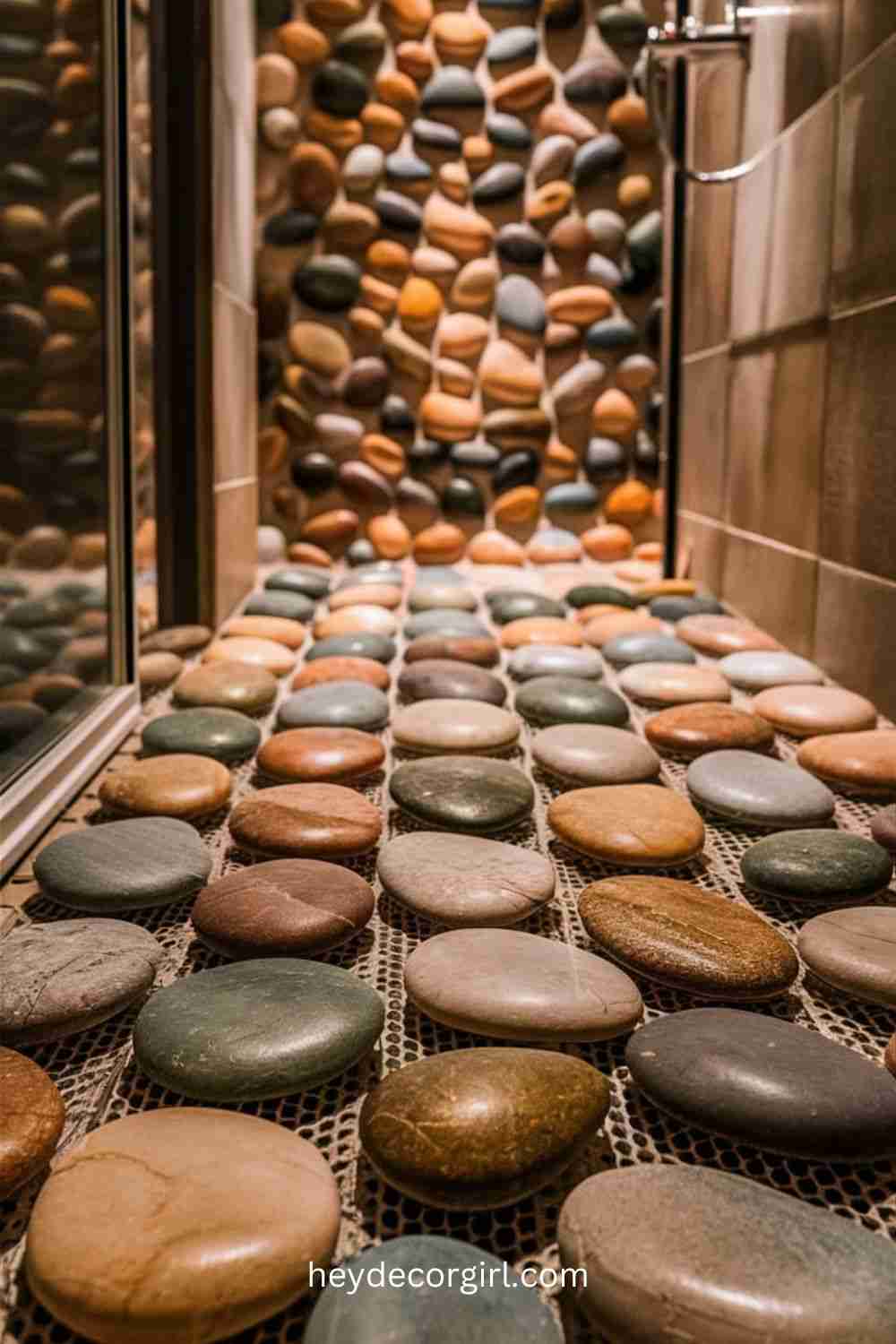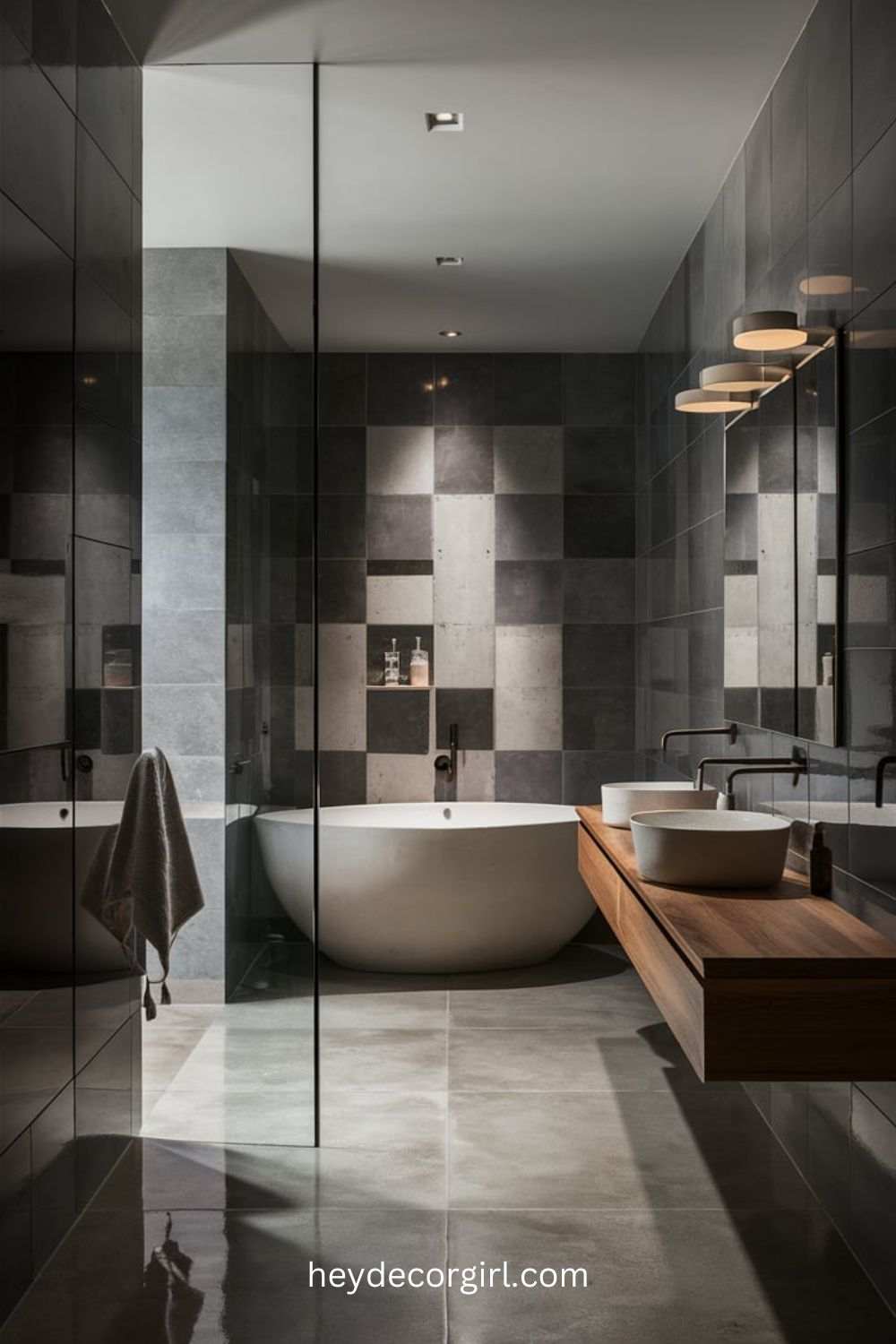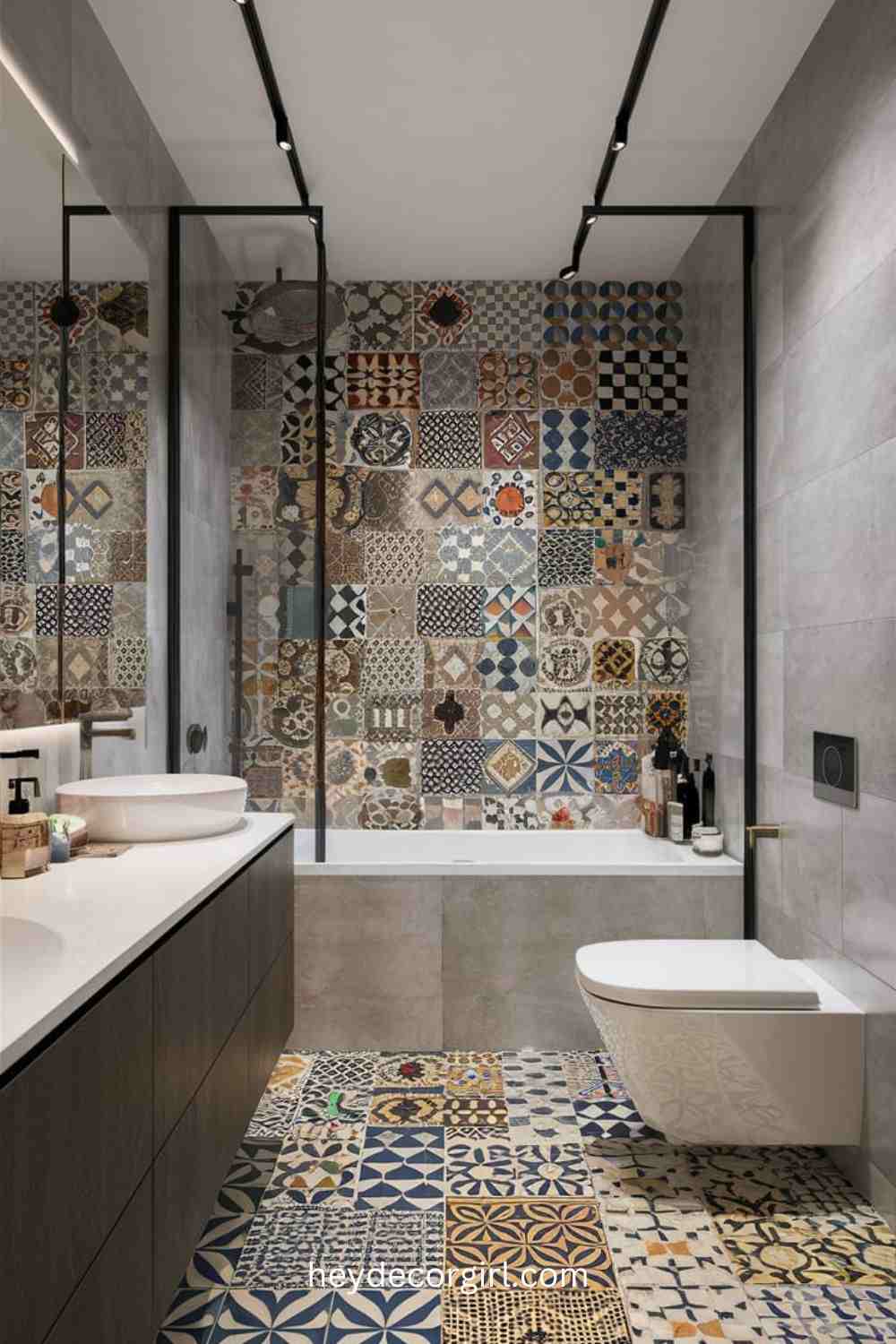When it comes to designing a bathroom, the floor tiles you choose play a crucial role in both functionality and aesthetics. Bathroom floor tile ideas are not just about choosing a design that looks great; they also need to stand up to the demands of a high-moisture environment. The shower floor, in particular, is exposed to constant water, steam, and foot traffic, making durability a top priority. However, this doesn’t mean you have to sacrifice style for sturdiness. In fact, today’s tile options offer a remarkable blend of durability and design, allowing you to create a beautiful and resilient space.
In this guide, we’ll explore a variety of bathroom floor tile ideas that are both durable and stylish, ensuring your shower floors not only enhance the look of your bathroom but also provide long-lasting performance. From classic ceramic and porcelain tiles to innovative cement and glass options, you’ll find plenty of inspiration to make a stylish yet practical choice for your bathroom floor.
Best Bathroom floor tile ideas
1. Classic Ceramic Tiles
Ceramic tiles have long been a staple in bathroom design due to their impressive durability and timeless appeal. Bathroom floor tile ideas often feature ceramic tiles because they are made from natural clay and fired at high temperatures, which makes them resistant to moisture, stains, and wear. This durability makes them an ideal choice for shower floors and other high-traffic areas. Their non-porous surface helps prevent mold and mildew, ensuring a cleaner and healthier bathroom environment. Additionally, ceramic tiles are available in a wide range of colors, patterns, and textures, allowing them to fit seamlessly into any design scheme.
Popular Patterns and Finishes
Ceramic tiles come in a variety of patterns and finishes, each offering its own unique aesthetic:
- Subway Tiles: This classic rectangular shape, often used in a brick-like pattern, provides a clean and simple look. Subway tiles are versatile and can be arranged in various orientations, such as vertical, herringbone, or offset, to create different visual effects.
- Hexagon Tiles: With their geometric charm, hexagon tiles add a touch of modern sophistication to your shower floor. Available in various sizes and finishes, hexagon tiles can create striking patterns that add texture and visual interest.
- Mosaic Tiles: Small mosaic tiles can be arranged to form intricate patterns or designs. Their flexibility allows for creative expression, from detailed designs to simple color gradients.
- Matte vs. Glossy Finishes: Matte finishes offer a non-slip surface, ideal for wet areas like shower floors, while glossy finishes reflect light and can make a space feel brighter and larger. Each finish provides different visual effects and practical benefits.
Best Practices for Maintenance and Cleaning
Maintaining ceramic tiles is relatively straightforward, but following these best practices will ensure they remain in top condition:
- Regular Cleaning: Sweep or vacuum the floor regularly to remove debris that could scratch the surface. Use a damp mop with a mild tile cleaner to clean the tiles, avoiding harsh chemicals that could damage the grout or tile surface.
- Grout Care: Grout lines between tiles can collect dirt and grime over time. To keep grout clean, use a grout cleaner or a mixture of baking soda and water. Apply with a soft brush and rinse thoroughly.
- Preventing Stains: For added protection, consider sealing the grout lines. This helps prevent stains and keeps the grout looking fresh. Reseal as needed, typically every six to twelve months, depending on traffic and usage.
- Dealing with Scratches: While ceramic tiles are durable, they can still be scratched. For minor scratches, a tile repair kit can help. For deeper damage, professional repair or replacement may be necessary.
By choosing classic ceramic tiles for your bathroom floor, you’re investing in a material that combines enduring style with practical durability. With a variety of patterns and finishes to choose from, you can create a shower floor that not only looks great but also stands up to daily wear and tear.
2. Elegant Porcelain Tiles
Porcelain tiles are renowned for their exceptional durability, making them an ideal choice for high-traffic areas, including bathroom floors and shower spaces. When considering bathroom floor tile ideas, porcelain tiles stand out because they are fired at higher temperatures than ceramic tiles, making them denser and less porous. This enhances their resistance to moisture, stains, and wear, which is crucial for environments with frequent water exposure, such as bathrooms. Additionally, porcelain tiles are less likely to chip or crack under heavy use, ensuring a long-lasting and low-maintenance flooring solution. Their ability to retain color and pattern consistency over time also makes them a practical choice for maintaining a fresh and stylish appearance.
Varieties of Porcelain Tiles
Porcelain tiles come in several varieties, each offering unique features and aesthetic options:
- Polished Porcelain Tiles: These tiles have a glossy, mirror-like finish that reflects light, creating a sophisticated and elegant look. They are often used in contemporary bathroom designs to add a touch of luxury. However, polished tiles may require more frequent cleaning to maintain their shine and can be slippery when wet, so consider this when choosing for shower floors.
- Matte Porcelain Tiles: Featuring a non-reflective surface, matte porcelain tiles offer a subtle, understated elegance. They are less prone to showing water spots and dirt, making them a practical option for bathroom floors and shower areas where slip resistance is important.
- Textured Porcelain Tiles: These tiles have a tactile surface that can mimic natural materials such as stone or wood. Textured tiles provide better slip resistance and add depth and interest to the bathroom design. They are excellent for creating a more natural or rustic look.
Design Tips for Incorporating Porcelain Tiles in Modern Bathrooms
- Create a Cohesive Look: Use porcelain tiles in coordinating colors and patterns to create a unified design. For example, pair large-format tiles with minimal grout lines for a sleek, seamless look or mix textured and polished tiles to add visual interest.
- Play with Patterns: Experiment with different laying patterns, such as herringbone, chevron, or staggered layouts, to add a unique touch to your bathroom. Porcelain tiles’ versatility allows for creative designs that can enhance the overall aesthetic of your space.
- Opt for Large-Format Tiles: Large-format porcelain tiles can make a small bathroom appear more spacious by reducing the number of grout lines and creating a streamlined look. They also minimize the maintenance required for grout, as there are fewer lines to clean.
- Incorporate Accent Tiles: Use porcelain accent tiles to create focal points or highlight specific areas, such as a feature wall or shower niche. Accent tiles can add pops of color or pattern, making your bathroom design more dynamic.
- Consider Floor-to-Wall Continuity: Extending porcelain tiles from the floor up the walls can create a cohesive and modern look. This approach enhances the sense of space and integrates the shower area seamlessly with the rest of the bathroom.
By choosing elegant porcelain tiles for your bathroom, you benefit from their durability and style versatility. With options ranging from polished to matte and textured finishes, you can tailor your design to fit your personal taste and create a sophisticated, modern bathroom space.
3. Versatile Vinyl Tiles
Vinyl tiles are a popular choice for bathroom flooring due to their cost-effectiveness and ease of installation. Here are some key advantages:
- Cost-Effectiveness: Vinyl tiles are generally more affordable than natural stone or high-end ceramic tiles. They offer a budget-friendly option without compromising on style or performance.
- Ease of Installation: Vinyl tiles are known for their straightforward installation process. Many options come with a peel-and-stick backing or interlocking design, making them suitable for DIY projects.
- Durability: Vinyl tiles are resistant to moisture, stains, and scratches. They are ideal for bathrooms where water and heavy foot traffic are common.
- Comfort: Vinyl tiles provide a softer surface compared to hard materials like ceramic or stone, making them more comfortable underfoot.
Styles and Patterns
Vinyl tiles come in a variety of styles and patterns, allowing you to achieve different looks for your bathroom:
- Luxury Vinyl Planks (LVP): These tiles mimic the appearance of natural wood or stone while offering the benefits of vinyl. They are available in various colors and textures, providing a high-end look without the maintenance required for real wood or stone.
- Vinyl Mosaic Tiles: Small vinyl mosaic tiles can create intricate patterns and designs. These tiles are often used as accents or in small areas to add visual interest and texture.
- Wood-Look Vinyl Tiles: Designed to replicate the look of hardwood, these tiles are perfect for achieving a warm, natural aesthetic in your bathroom. They come in various wood species and finishes.
- Stone-Look Vinyl Tiles: Emulating the appearance of natural stone, these tiles offer the elegance of materials like marble or granite with the durability and ease of maintenance of vinyl.
How to Achieve a High-End Look with Vinyl Tiles
To elevate the look of vinyl tiles and achieve a high-end appearance:
- Choose High-Quality Options: Opt for premium vinyl tiles with realistic textures and patterns. Luxury vinyl planks and high-definition designs can closely mimic natural materials.
- Use Grout Lines: Some vinyl tile designs include faux grout lines that enhance the look of the tiles. If not included, consider adding grout to create a more authentic tile appearance.
- Select Elegant Patterns: Choose patterns that add sophistication, such as herringbone or chevron layouts. These patterns can make the space appear more upscale.
- Coordinate with Fixtures and Accents: Match your vinyl tiles with high-quality fixtures and accents. Complementing elements like modern vanities, sleek faucets, and stylish lighting can enhance the overall look of the bathroom.
- Consider Tile Size and Layout: Larger tiles can create a more streamlined and upscale look, while smaller tiles or mosaics can add intricate detailing. Experiment with different layouts to find the most elegant design for your space.
By selecting the right styles and patterns, and employing these design strategies, you can achieve a luxurious and sophisticated look with versatile vinyl tiles, making them a practical yet stylish choice for your bathroom floor.
4. Stylish Natural Stone Tiles
Natural stone tiles offer a range of options, each with unique characteristics and aesthetics:
- Marble: Known for its luxurious appearance and veined patterns, marble tiles add a touch of elegance to any bathroom. They come in various colors, from classic whites and creams to more vibrant hues and dramatic veining.
- Granite: Renowned for its durability and strength, granite tiles are a great choice for high-traffic areas. They offer a natural speckled appearance and are available in a range of colors, including blacks, grays, and earth tones.
- Travertine: This porous stone has a unique texture and natural warmth. It often features earthy tones and a variety of surface finishes, from polished to tumbled. Travertine is ideal for creating a rustic or Mediterranean-inspired look.
- Limestone: Featuring a softer, more subtle appearance, limestone tiles offer a natural, understated elegance. They are typically available in shades of beige, gray, and brown and work well in both modern and traditional settings.
Durability and Maintenance Considerations
- Marble: While marble is beautiful, it is softer and more prone to scratching and staining compared to other stones. It requires regular sealing to protect against moisture and acids. Avoid using acidic cleaners, as they can damage the surface.
- Granite: Granite is highly durable and resistant to scratches, stains, and heat. It should be sealed periodically to maintain its resistance to stains and moisture. Regular cleaning with a mild, non-acidic cleaner is recommended.
- Travertine: Travertine is relatively durable but can be more susceptible to scratching and staining due to its porous nature. It should be sealed to prevent water absorption and staining. Regular cleaning with a pH-balanced cleaner will help maintain its appearance.
- Limestone: Limestone is softer and more porous, making it more susceptible to scratches and stains. It should be sealed to protect against moisture and dirt. Clean with a mild detergent and avoid harsh chemicals.
Design Ideas for Adding Luxury and Texture to the Bathroom
- Marble Accents: Use marble tiles to create a statement wall or shower surround. Pair with gold or chrome fixtures for a luxurious feel. Consider a marble mosaic or herringbone pattern for added visual interest.
- Granite Countertops: Complement granite flooring with matching or coordinating granite countertops. This creates a cohesive and sophisticated look throughout the bathroom.
- Travertine Walls: Use travertine tiles on shower walls or as a backsplash to add texture and warmth. Combine with natural wood accents or neutral-toned accessories for a rustic or organic vibe.
- Limestone Floors: Opt for large-format limestone tiles to create a serene and spacious look. Incorporate a textured finish or unique laying patterns to enhance the natural beauty of the stone.
- Mixed Stone Designs: Combine different types of natural stone tiles to create a dynamic and luxurious bathroom design. For example, use marble for the floor and granite for the shower walls, or mix travertine and limestone for a rich, layered effect.
- Feature Walls: Create a dramatic feature wall with a unique stone, such as a mosaic of marble or a combination of different stones. This can serve as a focal point and add depth to the bathroom design.
By incorporating natural stone tiles, you can enhance the luxury and texture of your bathroom, creating a timeless and elegant space. Each type of stone offers its own charm and character, allowing you to design a bathroom that is both stylish and durable.
5. Innovative Cement Tiles
Cement tiles are renowned for their distinctive and customizable designs. Here are some of the unique patterns and styles available:
- Geometric Patterns: Show images of cement tiles featuring intricate geometric patterns, such as hexagons, diamonds, and chevrons. These designs can create striking visual effects and add a modern touch to the bathroom.
- Colorful Motifs: Highlight vibrant and colorful cement tile designs, including floral motifs or abstract art. These tiles can serve as bold accents or focal points in a bathroom.
- Custom Designs: Illustrate examples of custom-designed cement tiles, showcasing how they can be tailored to fit specific aesthetic preferences or thematic elements in a bathroom.
- Textured Finishes: Include images of cement tiles with various textures, such as embossed or patterned surfaces, which add depth and tactile interest to the floor or walls.
Durability and Best Uses in Shower Floors
Cement tiles are durable but require proper care to maintain their appearance:
- Durability: Show close-ups of cement tiles to demonstrate their sturdiness and ability to withstand foot traffic and moisture. Emphasize their resistance to cracking and long-lasting performance when installed correctly.
- Best Uses: Illustrate cement tiles used effectively in shower floors, demonstrating how they handle water exposure and provide a non-slip surface. Include images of proper sealing and maintenance practices to ensure longevity.
Tips for Incorporating Cement Tiles into Contemporary Designs
To integrate cement tiles into modern bathroom designs, consider the following tips:
- Contrast and Complement: Use cement tiles to contrast with other materials, such as sleek glass or metal fixtures. This juxtaposition creates a balanced and contemporary look.
- Accent Walls: Incorporate cement tiles as accent walls or backsplash areas. Show how a feature wall with a bold cement tile pattern can serve as a focal point in a contemporary bathroom design.
- Neutral Backgrounds: Pair colorful or intricate cement tiles with neutral backgrounds, such as white or gray walls and floors, to allow the tiles to stand out without overwhelming the space.
- Mix with Modern Fixtures: Combine cement tiles with modern fixtures and furnishings, such as minimalist vanities, floating sinks, and chrome hardware. This combination highlights the tile’s contemporary appeal while maintaining a cohesive design.
- Seamless Integration: Showcase how cement tiles can be integrated seamlessly with other materials, like transitioning from tile to wood or stone. This approach can enhance the flow and coherence of the design.
By highlighting the unique designs, durability, and integration tips for cement tiles, you can showcase their versatility and appeal in contemporary bathroom settings.
6. Charming Glass Tiles
Glass tiles offer a range of benefits that make them a popular choice for stylish bathroom designs:
- Light Reflection: Glass tiles are renowned for their ability to reflect light, which can make a space feel brighter and more open. Show images of glass tiles installed in a bathroom where their reflective quality enhances the overall luminosity of the room.
- Color Options: Glass tiles come in a wide array of colors and finishes, from clear and frosted to vibrant hues and metallics. Include images of various color options, showcasing how they can be used to create different moods and styles.
- Visual Appeal: The unique shine and transparency of glass tiles can add a luxurious and elegant touch to any space. Display examples of how glass tiles contribute to a sophisticated and modern aesthetic.
Design Ideas for Creating Visually Striking Shower Floors
- Mosaic Patterns: Highlight a shower floor covered with glass mosaic tiles arranged in intricate patterns or designs. Show how the tiles’ reflective quality can enhance the visual interest of the floor.
- Accent Areas: Feature images of glass tiles used as accent areas within the shower, such as a stripe or border. This can add a pop of color and sparkle without overwhelming the space.
- Color Gradients: Show glass tiles arranged in gradient patterns, where colors blend from light to dark. This technique can create a striking visual effect and add depth to the shower floor.
- Tile Combinations: Include examples of glass tiles combined with other materials, such as ceramic or stone. This can create a dynamic and stylish look while showcasing the versatility of glass tiles.
Care and Cleaning Tips for Maintaining Glass Tiles
- Regular Cleaning: Display an image of a person cleaning glass tiles with a gentle, non-abrasive cleaner. Emphasize the importance of using pH-balanced cleaners to avoid damaging the tile’s surface.
- Avoiding Streaks: Show techniques for cleaning glass tiles to avoid streaks, such as using a microfiber cloth or squeegee. This helps to maintain the tiles’ shine and clarity.
- Grout Maintenance: Include images of grout cleaning or sealing around glass tiles. Proper grout maintenance is essential to prevent staining and keep the tiles looking pristine.
- Preventing Damage: Illustrate precautions to prevent damage to glass tiles, such as avoiding harsh chemicals or abrasive scrubbers. Show how to handle and install glass tiles carefully to avoid chipping or cracking.
By showcasing these aspects of glass tiles, you can highlight their benefits, design versatility, and maintenance requirements, helping to create a visually striking and well-maintained bathroom space.
7. Trendy Terracotta Tiles
- Warmth and Texture: Show close-up images of terracotta tiles to highlight their rich, warm hues and natural texture. Include details of the tile’s earthy tones, such as reds, oranges, and browns, and how these contribute to a cozy and inviting atmosphere.
- Handcrafted Appearance: Display examples of terracotta tiles with a handcrafted look, including variations in color and texture that emphasize their artisanal quality.
- Aged and Patina Effects: Include images of aged terracotta tiles that showcase the beautiful patina and subtle variations that develop over time, adding character and depth to the tiles.
Suitability for Different Bathroom Styles
- Rustic Style: A bathroom featuring terracotta tiles in a rustic setting, with natural wooden elements, stone accents, and earthy colors. Show how terracotta tiles complement rustic design elements, creating a warm and inviting space.
- Mediterranean Style: Illustrate a Mediterranean-inspired bathroom with terracotta tiles, paired with colorful mosaics, wrought iron fixtures, and vibrant textiles. Highlight how terracotta tiles enhance the Mediterranean aesthetic with their traditional look and feel.
- Modern and Contemporary: A bathroom with a modern or contemporary design that incorporates terracotta tiles. Show how these tiles can be used in a sleek and minimalistic setting to add warmth and contrast against more modern materials.
How to Maintain and Protect Terracotta Tiles
- Sealing: Images of sealing terracotta tiles to protect them from moisture and stains. Show the application process and emphasize the importance of regular sealing to maintain the tile’s appearance and durability.
- Cleaning: Demonstrate proper cleaning techniques for terracotta tiles, using a gentle pH-balanced cleaner and soft cleaning tools. Include images of the cleaning process to highlight best practices.
- Avoiding Damage: Show precautions to prevent damage to terracotta tiles, such as using protective mats or furniture pads to avoid scratches. Illustrate how to address spills and stains promptly to prevent lasting damage.
- Routine Maintenance: Include images of routine maintenance tasks, such as sweeping and mopping with appropriate products. Emphasize the importance of maintaining a regular cleaning schedule to keep the tiles in good condition.
By showcasing the characteristics, suitability for various styles, and maintenance tips for terracotta tiles, you can highlight their versatility and beauty, making them an appealing choice for diverse bathroom designs.
8. Unique Pebble Tiles
Pebble tiles bring a distinctive and natural charm to bathroom floors. Composed of smooth, rounded stones arranged in a mesh backing, these tiles offer a unique textural experience underfoot. The natural variations in color and shape of the pebbles create a soothing, spa-like atmosphere that enhances the overall aesthetic of your bathroom. The irregular surfaces of pebble tiles not only add visual interest but also provide a pleasant tactile sensation, making them a popular choice for those seeking a more organic and earthy look.
Ideal Uses for Pebble Tiles in Shower Floors and Wet Areas
Pebble tiles are particularly well-suited for use in shower floors and wet areas due to their water-resistant properties and slip-resistant texture. The natural stones help to drain water effectively, reducing the risk of slipping and making them a practical choice for high-moisture environments. Their ability to handle constant exposure to water while maintaining their appearance makes them an excellent option for shower floors, accent walls, and even pool surrounds. Pebble tiles can create a seamless, flowing look that integrates beautifully with both traditional and modern bathroom designs.
Tips for Installation and Maintenance
1. Installation:
- Surface Preparation: Ensure that the surface where the pebble tiles will be installed is clean, dry, and level. Any imperfections in the surface can affect the tile’s adhesion and overall appearance.
- Adhesive: Use a high-quality thin-set mortar suitable for wet areas. Apply the mortar evenly and press the pebble tiles firmly into place, ensuring that they are aligned correctly.
- Grouting: Choose a grout that complements the color of the pebbles. Because pebble tiles have uneven surfaces, use a grout float to fill in the gaps and remove excess grout from the tile’s surface. It’s important to use a grout release or sealer to prevent staining.
2. Maintenance:
- Regular Cleaning: Sweep or vacuum the area regularly to remove debris. For a deeper clean, use a mild detergent and warm water. Avoid acidic or abrasive cleaners that can damage the grout or stone.
- Sealing: To protect the natural stones and grout from moisture and stains, apply a sealant specifically designed for natural stone. Reseal the tiles periodically, as recommended by the manufacturer, to maintain their appearance and durability.
- Avoiding Mold: Keep the shower area well-ventilated to prevent mold and mildew growth. Regularly inspect grout lines and reseal if necessary to keep the area clean and dry.
By incorporating pebble tiles into your bathroom design, you can enjoy both their aesthetic appeal and practical benefits, creating a space that feels both luxurious and functional.
9. Contemporary Concrete Tiles
Concrete tiles offer a range of benefits that make them a popular choice for modern bathrooms. One of their most significant advantages is customization. Concrete tiles can be poured and molded into virtually any shape or size, allowing for endless design possibilities. This customization extends to color and texture, as concrete tiles can be stained, tinted, or textured to match a wide variety of aesthetic preferences.
In terms of durability, concrete tiles are incredibly robust and can withstand heavy foot traffic and high moisture levels, making them ideal for bathroom environments. They are also resistant to scratching and fading, ensuring that they maintain their appearance over time with minimal upkeep. Additionally, concrete tiles can be sealed to enhance their resistance to water and stains, further extending their lifespan and performance.
Design Possibilities and Finishes
Concrete tiles come in various finishes and styles that can complement a range of modern bathroom designs:
- Stained Concrete Tiles: These tiles are infused with color to achieve a rich, uniform appearance. Staining allows for a wide spectrum of colors, from deep, vibrant tones to subtle pastels. This finish is ideal for creating a cohesive look that aligns with contemporary color schemes.
- Polished Concrete Tiles: Polished concrete tiles offer a sleek, glossy finish that reflects light, adding a touch of sophistication to any space. This finish is excellent for creating a modern, high-end look and is particularly effective in small bathrooms where reflecting light can enhance the sense of space.
- Textured Concrete Tiles: For a more tactile experience, textured concrete tiles add depth and interest to the floor. Textures can range from subtle patterns to more pronounced designs, providing visual and physical contrast that can be both functional and decorative.
How to Integrate Concrete Tiles into Modern Bathroom Designs
- Minimalist Aesthetics: Concrete tiles complement minimalist bathroom designs with their clean lines and understated elegance. Pair them with neutral colors, simple fixtures, and natural materials to create a serene, uncluttered space.
- Industrial Style: Embrace the raw, unfinished look of concrete tiles in an industrial-themed bathroom. Combine them with exposed pipes, metal accents, and brick or wood elements for a rugged yet refined aesthetic.
- Contrasting Elements: Use concrete tiles to contrast with softer materials like wood or textiles. For instance, a polished concrete floor can be balanced with warm wooden cabinetry or plush rugs to create a harmonious mix of textures.
- Accent Walls and Patterns: In addition to flooring, consider using concrete tiles on accent walls or as part of patterned designs. Geometric patterns or bold, large-scale tiles can make a statement and add visual interest to the bathroom.
- Seamless Integration: To achieve a seamless look, extend the use of concrete tiles beyond the floor. Use them on walls, in shower areas, or even as part of custom countertops and sinks to create a cohesive design.
By leveraging the versatility and durability of concrete tiles, you can create a modern bathroom that is both stylish and functional, reflecting the latest trends in contemporary design.
10. Patterned and Decorative Tiles
Patterned and decorative tiles are an excellent way to inject personality and visual intrigue into a bathroom design. By incorporating these tiles, you can create focal points, highlight specific areas, or introduce a playful element to the space. The diverse range of patterns—from intricate geometric designs to bold florals—allows you to customize the look of your bathroom, making it a unique reflection of your style. Patterned tiles can transform a simple bathroom into a visually stimulating space that captivates attention and enhances the overall aesthetic.
Examples of Popular Patterns and Their Applications
- Geometric Patterns:
- Hexagon Tiles: These create a honeycomb effect that can be used on floors or walls. Their versatility makes them suitable for both contemporary and traditional bathrooms.
- Chevron and Herringbone: These patterns add a dynamic and directional flow to the room. They are often used as statement floors or backsplash designs to draw the eye.
- Subway Tiles:
- Classic Subway: Traditionally used in a brick pattern, these tiles are now available in various colors and sizes, offering a timeless look that can be both modern and classic.
- Vertical or Diagonal Subway: Altering the orientation of subway tiles can create a fresh and unique look, ideal for accent walls or shower surrounds.
- Mosaic Patterns:
- Small-Scale Mosaics: These can be used to create intricate designs or color gradients. They are often applied as borders, feature walls, or backsplashes.
- Arabesque and Moroccan Tiles: Known for their elaborate, flowing designs, these tiles are perfect for creating a dramatic effect in both floors and walls.
- Bold and Graphic Patterns:
- Retro and Vintage Designs: These tiles often feature intricate designs and vibrant colors, perfect for adding a touch of nostalgia or character to your bathroom.
- Graphic Prints: Modern, abstract patterns can be used to create a striking focal point, such as a feature wall or floor.
Balancing Decorative Tiles with Functional Needs
When incorporating patterned and decorative tiles, it’s essential to strike a balance between aesthetics and practicality:
- Focus Areas: Use patterned tiles strategically in areas where they will have the most visual impact, such as accent walls, shower niches, or as a backsplash. This prevents overwhelming the space and ensures that the decorative elements stand out.
- Complementary Elements: Pair patterned tiles with more neutral or simple tiles to avoid visual clutter. For instance, a bold patterned floor can be balanced with plain walls or vice versa.
- Functionality: Ensure that the decorative tiles are appropriate for their use. For instance, choose tiles with a slip-resistant surface for floors, and ensure that wall tiles are suitable for wet areas.
- Maintenance: Consider the ease of cleaning and maintenance. Intricate patterns may require more effort to clean grout lines, so choose designs that align with your willingness to maintain them.
By thoughtfully incorporating patterned and decorative tiles, you can enhance your bathroom’s visual appeal while maintaining functionality and practicality.
Conclusion
Choosing the right bathroom floor tile is essential for creating a space that combines both durability and style. The bathroom floor is subjected to daily wear and tear, moisture, and occasional spills, making durability a crucial factor in tile selection. At the same time, the tile you choose sets the tone for the entire bathroom, contributing to its overall aesthetic appeal and creating a space that reflects your personal style.
By considering various tile options—from classic ceramics and elegant porcelains to innovative concrete and unique pebble tiles—you can find a solution that meets your practical needs while enhancing the visual interest of your bathroom. Each type of tile offers distinct benefits and design possibilities, allowing you to create a bathroom that is not only functional but also visually stunning.
FAQ
1. What types of bathroom floor tiles are most durable?
- Answer: The most durable bathroom floor tiles include porcelain, ceramic, natural stone (such as granite or slate), and large-format tiles. Bathroom floor tile ideas such as porcelain and ceramic tiles are particularly known for their resilience and low maintenance.
2. Are there specific tiles that work best for shower floors?
- Answer: For shower floors, consider Bathroom Floor Tile Ideas that offer slip resistance and water resistance. Mosaic tiles, textured porcelain, and natural stone tiles are popular choices. Ensure the tiles have a slip-resistant rating for safety.
3. How do I choose between porcelain and ceramic tiles for my bathroom floor?
- Answer: Both porcelain and ceramic tiles are durable, but porcelain tiles are denser and more water-resistant, making them a better option for high-moisture areas. Ceramic tiles are generally more cost-effective and come in a variety of styles, making them great Bathroom Floor Tile Ideas.
4. Can I use natural stone tiles in a shower?
- Answer: Yes, natural stone tiles like marble, granite, and travertine can be used in showers. When considering bathroom floor tile ideas, these materials offer a luxurious and timeless look. However, they require proper sealing to protect against moisture and staining. Ensure regular maintenance to keep them looking their best.
5. What are the benefits of using large-format tiles in a bathroom?
- Answer: Large-format tiles can create a sleek, modern look with fewer grout lines, making the space appear larger and less cluttered. When considering bathroom floor tile ideas, opting for these large-format tiles can also reduce the amount of grout needed, which can be easier to clean and maintain.
6. Are there any new trends in bathroom floor tiles for 2024?
- Answer: Trends for 2024 include bathroom floor tile ideas featuring bold geometric patterns, textured finishes, and natural stone looks. There’s also a growing interest in eco-friendly materials and tiles that mimic the appearance of wood or concrete.
7. How can I ensure my bathroom floor tiles are properly installed?
- Answer: For the best results, have your tiles installed by a professional. Ensure the surface is properly prepared, use the correct adhesive and grout, and follow the manufacturer’s recommendations for installation and maintenance. Consider exploring various Bathroom Floor Tile Ideas to find a style that complements your space.
8. What are some budget-friendly options for stylish bathroom floor tiles?
- Answer: Budget-friendly options include ceramic tiles, basic porcelain tiles, and vinyl tiles that mimic the look of more expensive materials. For more inspiration, explore various Bathroom Floor Tile Ideas. Look for sales and discounts at tile retailers to find stylish options within your budget.
9. How do I maintain and clean bathroom floor tiles?
- Answer: Regular sweeping or vacuuming, followed by mopping with a mild cleaner, is usually sufficient for most tiles. For Bathroom Floor Tile Ideas, avoid harsh chemicals that can damage the surface. For grout, use a dedicated grout cleaner and a soft brush to keep it looking clean.
10. Are there eco-friendly tile options available for bathrooms?
- Answer: Yes, there are several eco-friendly tile options, such as recycled glass tiles, tiles made from reclaimed materials, and those produced using sustainable practices. For bathroom floor tile ideas, look for certifications like LEED or GreenGuard to ensure environmental friendliness.

Hi, I’m Richa, the creative mind and passionate soul behind Hey Decor Girl. With a bachelor’s degree in Inter-space Design and a deep love for transforming spaces, I’ve dedicated my career to bringing style, comfort, and personality into homes. As an interior designer and architect, I’ve had the pleasure of crafting unique living environments that reflect the individuality of those who live in them.
At Hey Decor Girl, I share my expertise in all things home decor—from cozy living room makeovers to rustic farmhouse designs and everything in between. My mission is to inspire you to create spaces that not only look stunning but also feel like home. Whether you’re looking for the latest trends or timeless classics, I’m here to guide you every step of the way. Let’s make your dream home a reality, one stylish detail at a time.
Bathroom Floor Tile Ideas bathroomfloor floor tile ideas stylish shower floors
Last modified: August 27, 2024
![Hey Decor Girl [Latest Trending Decor Design Ideas]](https://heydecorgirl.com/wordpress/wp-content/uploads/2024/08/Heygirldecor-Logo.png)
